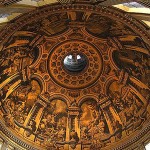One Space, Not Two
If you ever want to have someone look at you like you’re crazy, misguided and in general completely wrong—and inspire in them the absolute and total confidence that they, in turn, are entirely and absolutely right—then try this: Tell them that after a period, there should only be one space, not two.
In fact, I’m guessing that, as you read that last sentence, there’s a very good chance you’re thinking just that: “Oh, he must have made a mistake. Everyone, you’re thinking, knows that after a period you type two spaces, not just one.”
Nope. No mistake. I wrote it correctly. After a period, there should only be one space.
Really.
I’ve had this conversation many times in my life, and the results are always the same. Whether it’s with former colleagues at the PR agency I worked for in California, or my relative who teaches typing in high school, or friends and colleagues, they all look at me like I’m crazy and need to do more homework.
There are plenty of parallels to the debate about spaces after periods—contested subjects that people think they understand, but about which they are in many ways simply and factually wrong.
The strange thing is, though, that I’ve actually done the homework. And all of the experts in the field—graphic designers, typographers, publishers—agree. Unanimously. Without question. Incontrovertibly. They say, together, in one voice, the same thing: There should only be one space after a period, not two.
Don’t believe me? Read this summary of the topic in Slate by Farhad Manjoo, where he opens with: “Typing two spaces after a period is totally, completely, utterly, and inarguably wrong.” Read Robert Bringhurst’s classic Elements of Typographic Style, where the section on this topic is titled, simply and directly: “Use a single word space between sentences.” Check out Jim Godfrey’s poster, 34 Typographic Sins, where “Two spaces between sentences” gets pride of place as the very first sin he lists. The remedy: “Repent of this sin by using only one space.”
Here’s the thing: while I happen to be passionate about this topic—unnecessarily so, according to my children—misunderstandings about this aren’t going to affect most lives one way or the other.
But there are plenty of parallels to the debate about spaces after periods—contested subjects that people think they understand, but about which they are in many ways simply and factually wrong—which are far more important. These do get in the way of correctly understanding the Christian heritage of our Western civilization, and therefore get in the way of our own self-understanding.
Among these misunderstandings are the following bits of assumed wisdom, which—like the number of spaces after a sentence—everyone knows must be true, even when they are often not only wrong, but often the opposite of the truth. For example:
- Assumed wisdom: Faith and science are forever and always at odds.
Actual fact: The truth is that the Christian tradition has been, century after century, remarkably hospitable, not hostile, to science and scientific developments.
- Assumed wisdom: The story of Western civilization is largely the story of heroes like Galileo and Columbus, who fearlessly led the way for progress by challenging the widely held assumptions of a backwards and oppressive church hierarchy.
Actual fact: Again, this simply isn’t true. The Galileo affair, for one, is wildly misunderstood, but was as much about a conflict of personalities—for which Galileo shares at least as much blame as the pope—as it was about the findings of empirical science. As for Columbus—a faithful Catholic—he didn’t need to prove to anyone that the world was round. Everyone—including his Catholic friends and colleagues—knew without a doubt that the world was round long before he ever set sea for the New World.
- Assumed wisdom: “The Inquisition” was the height of Christian intolerance, power-mongering and general abuse.
Actual fact: People of the time who were accused of a crime preferred the church-sponsored inquisitional trials—based on Roman systems of law that were just being rediscovered—over the secular courts, because they knew they would be given a more fair, impartial and unbiased trial that was actually based on evidence. The inquisitional system, in fact, was such an improvement over the prior system of legal justice that, as James Hannam writes, it still “forms the backbone of criminal investigation in continental Europe to this day.”
- Assumed wisdom: If the world could only get rid of all religion, peace would finally have a chance, and respect for all human beings would naturally and automatically follow.
Actual fact: This one is as bizarre as any of the other myths noted above, because, in fact, the world has tried this experiment. It was called the 20th Century, during which time explicitly atheist regimes under leaders like Stalin, Pol Pot, Mao and Hitler gave us empirical evidence that yes, removing God from human civilization does indeed change things, but not, apparently, for the better. Those regimes together killed more than 100 million innocent human lives. Anyone who believes that religion is the primary cause of violence in the world has some serious explaining to do about the devastation caused by these self-identified a-religious political movements.
The list could be expanded: As James Hannam, again, writes: “The Church never supported the idea that the earth is flat, never banned human dissection, never banned the zero, and certainly never burned anyone at the stake for scientific ideas.”
I know, I know. By now, you’re probably thinking: Boy, he’s crazier than I thought. It’s so much worse than just “One space or two?”
Before you write me, though, to tell me just how crazy I am, consider reading books like these: James Hannam’s The Genesis of Science: How the Christian Middle Ages Launched the Scientific Revolution, or Stephen M. Barr’s Modern Physics and Ancient Faith, or Timothy Keller’s The Reason for God: Belief in an Age of Skepticism, or Dinesh D’Souza’s What’s So Great About Christianity, or Robert Royal’s The God Who Did Not Fail: How Religion Built and Sustains the West.
After you’ve read one or two or three of them, then you can write me to tell me I’m crazy.
And when you do, if you don’t mind, would you—please—only put a single space after the periods?














Terrific as always, Tim.
Your point on “One Space, Not Two” is very well taken. It also points out how much of the time proper research (or any research for that matter) is simply not done before a particular point of view is adopted and consequently espoused as the truth (I include myself in this group). I heard long ago that truth is defined not as what actually occurred, but what we agree occurred, injecting ourselves in the middle of a seemingly objective perspective. For example, prior to the earth being round, as is the truth now, it actually was flat. Just ask anyone at the time. And that was the truth.
But to your point on spacing, for years I have been a self-appointed grammarian officer, tasked with policing my small piece of the world and pointing out grammar and spelling mistakes as I discover them (express lanes in grocery stores with signs reading “10 items or less” just kills me). I’ve always been a “two space after periods” person. Changing this behavior will take some time, but with dogged commitment, I believe it’ll be done. Just think of the time it will save…
I continue to enjoy your perspective. Thank you for sharing it.